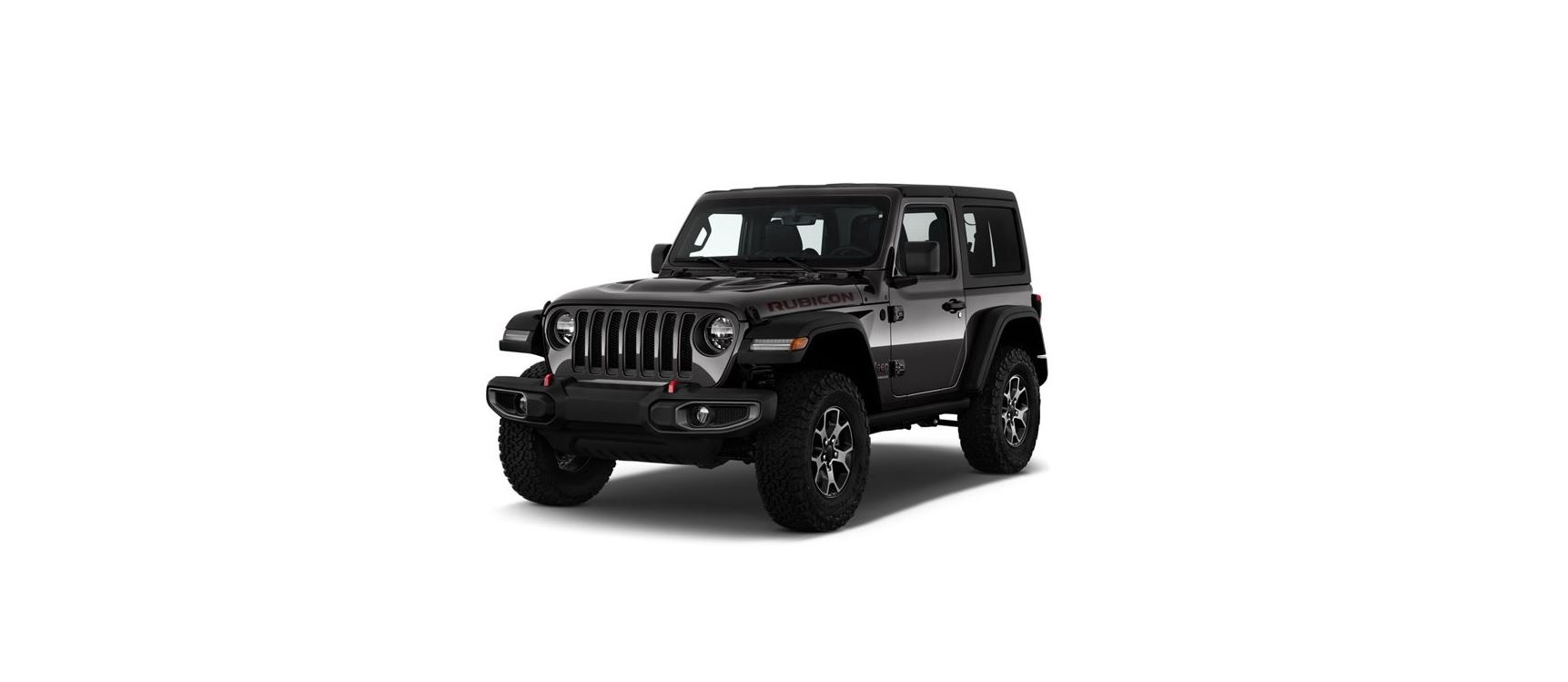2022 Jeep Wrangler Vehicle Maintenance User Manual
VEHICLE MAINTENANCE
An authorized dealer has the qualified service personnel, special tools, and equipment to perform all service operations in an expert manner. Service Manuals are available which include detailed service information for your vehicle. Refer to these Service Manuals before attempting any procedure yourself.
NOTE:
Intentional tampering with emissions control systems may void your warranty and could result in civil penalties being assessed against you.
WARNING!
You can be badly injured working on or around a motor vehicle. Only do service work for which you have the knowledge and the proper equipment. If you have any doubt about your ability to perform a service job, take your vehicle to a competent mechanic.
ENGINE OIL
Engine Oil Selection
For engine oil selection Ú page 424.
American Petroleum Institute (API) Approved Engine Oil
These symbols mean that the oil has been certified by the API. The manufacturer only recommends API trademark oils.
![]() The API Starburst trademark certifies 0W-20, 0W-30 and 5W-30 engine oils.
The API Starburst trademark certifies 0W-20, 0W-30 and 5W-30 engine oils.
![]() The API Donut trademark certifies 0W-40 and 5W-40 engine oil.
The API Donut trademark certifies 0W-40 and 5W-40 engine oil.
CAUTION!
Do not use chemical flushes in your engine oil as the chemicals can damage your engine. Such damage is not covered by the New Vehicle Limited Warranty.
Synthetic Engine Oils
Your engine was designed for synthetic engine oils, only use synthetic API approved engine oils. Synthetic engine oils which do not have both the correct API trademark and the correct SAE viscosity grade numbers should not be used.
Materials Added To Engine Oil
The manufacturer strongly recommends against the addition of any additives (other than leak detection dyes) to the engine oil. Engine oil is an engineered product and its performance may be impaired by supplemental additives.
Disposing Of Used Engine Oil And Oil Filters
Care should be taken in disposing of used engine oil and oil filters from your vehicle. Used oil and oil filters, indiscriminately discarded, can present a problem to the environment. Contact an authorized dealer, service station or governmental agency for advice on how and where used oil and oil filters can be safely discarded in your area.
ENGINE OIL FILTER
The engine oil filter should be replaced with a new filter at every engine oil change.
Engine Oil Filter Selection
A full-flow type disposable oil filter should be used for replacement. The quality of replacement filters varies considerably. Only high quality Mopar® filters should be used.
ENGINE AIR CLEANER FILTER
For the proper maintenance intervals Ú page 348 for gasoline engines or Ú page 352 for diesel engines.
NOTE:
Be sure to follow the “Severe Duty Conditions” maintenance interval if applicable.
WARNING!
The air induction system (air cleaner, hoses, etc.) can provide a measure of protection in the case of engine backfire. Do not remove the air induction system (air cleaner, hoses, etc.) unless such removal is necessary for repair or maintenance. Make sure that no one is near the engine compartment before starting the vehicle with the air induction system (air cleaner, hoses, etc.) removed. Failure to do so can result in serious personal injury.
Engine Air Cleaner Filter Selection
The quality of replacement engine air cleaner filters varies considerably. Only high quality Mopar® filters should be used.
Engine Air Cleaner Filter Inspection and Replacement— Gasoline Engine
Follow the recommended maintenance intervals as shown in the Maintenance Schedule in this section.
Engine Air Cleaner Filter Removal
- Loosen the fasteners from the engine air cleaner filter cover using a suitable tool.
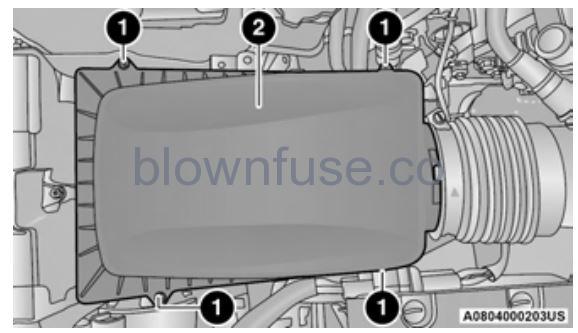
- Fasteners
- Engine Air Cleaner Filter Cover
- Lift the engine air cleaner filter cover to access the engine air cleaner filter.
- Remove the engine air cleaner filter from the housing assembly.
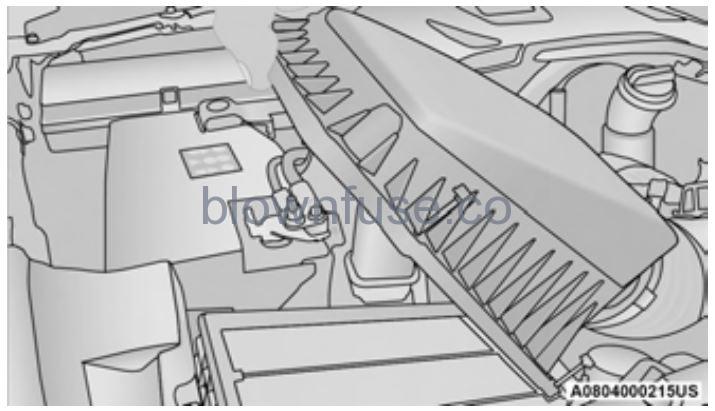
Engine Air Cleaner Filter Installation
NOTE:
Inspect and clean the housing if significant dirt or debris is present before replacing the engine air cleaner filter.
- Install the engine air cleaner filter into the housing assembly with the engine air cleaner filter inspection surface facing downward.
- Tighten engine air cleaner filter cover fasteners using a suitable tool.
CAUTION!
Do not overtighten the engine air cleaner filter cover lid screws or damage may result.
Engine Air Cleaner Filter Inspection and Replacement — Diesel Engine
Follow the recommended maintenance intervals as shown in the Maintenance Schedule in this section.
Engine Air Cleaner Filter Removal
- Loosen the fasteners from the engine air cleaner filter cover using a suitable tool.
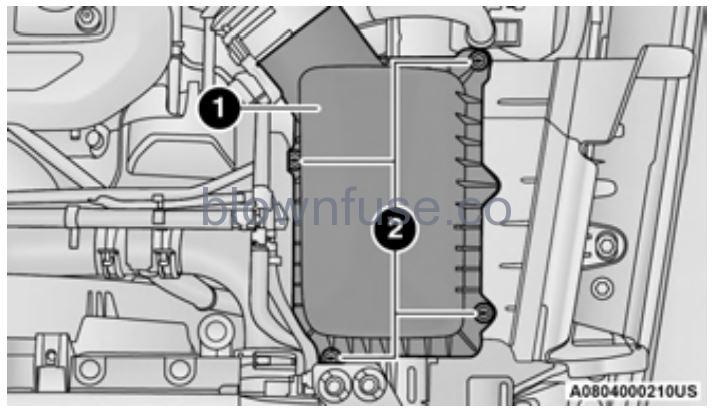
- Engine Air Cleaner Filter Cover
- Fasteners
- Lift the engine air cleaner filter cover to access the engine air cleaner filter.
- Remove the engine air cleaner filter from the housing assembly.
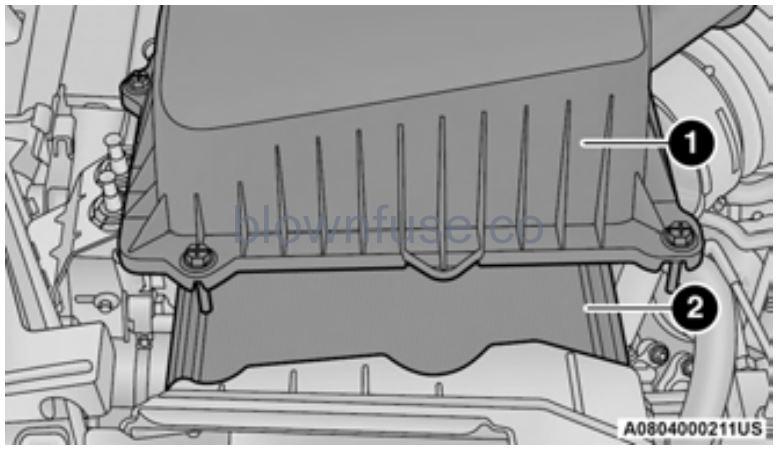
- Engine Air Cleaner Filter Cover
- Engine Air Cleaner Filter
Engine Air Cleaner Filter Installation
NOTE:
Inspect and clean the housing if significant dirt or debris is present before replacing the engine air cleaner filter.
- Install the engine air cleaner filter into the housing assembly with the engine air cleaner filter inspection surface facing downward.
- Tighten engine air cleaner filter cover fasteners using a suitable tool.
CAUTION!
Do not overtighten the engine air cleaner filter cover lid screws or damage may result.
DRAINING FUEL/WATER SEPARATOR FILTER — DIESEL ENGINE
The fuel/water separator housing is located inside the left frame rail in front of the fuel tank. The best access to this water drain valve is from under the vehicle.
CAUTION!
- Do not drain the fuel/water separator filter when the engine is running.
- Diesel fuel will damage blacktop paving surfaces. Drain the filter into an appropriate container.
If necessary remove the fuel filter protective cover to access the water drain valve.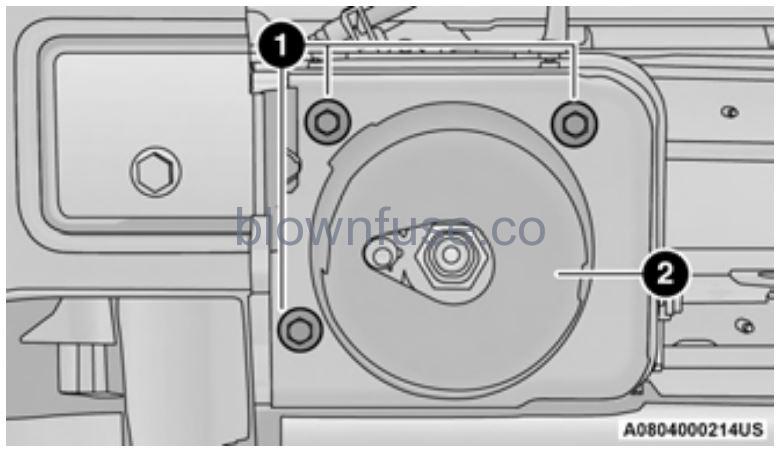
Fuel/Water Separator Filter
- Retainers
- Fuel Filter Protective Cover
If water is detected in the water separator while the engine is running, or while the ignition switch is in the ON position, the Water In Fuel Indicator Light will illuminate and an audible chime will be heard. At this point you should stop the engine and drain the water from the filter housing.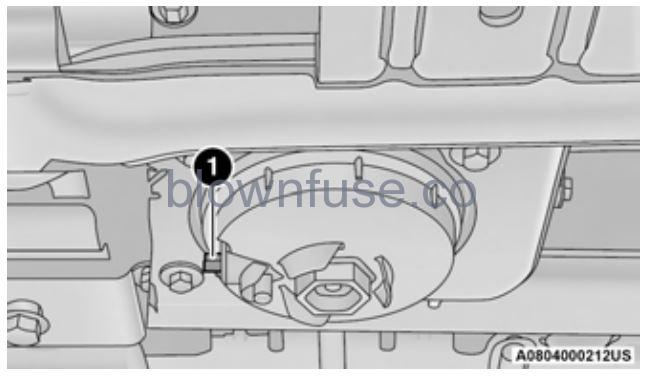
- Water In Fuel Drain Valve
Within 10 minutes of vehicle shutdown, turn the filter drain valve (located on the bottom of the filter housing) counterclockwise to drain fuel/water; allow the accumulated water to drain. Leave the drain valve open until all water and contaminants have been removed. When clear fuel is visible, close the drain valve by turning it clockwise. Upon proper draining of the water from fuel filter assembly, the Water In Fuel Indicator Light will remain illuminated for approximately 10 seconds. If the water was drained while the engine was running, the Water In Fuel Indicator Light may remain on for approximately three minutes.
NOTE:
Care should be taken in disposing of used fluids from your vehicle. Used fluids, indiscriminately discarded, can present a problem to the environment. Contact an authorized dealer, service station, or government agency for advice on recycling programs and for where used fluids and filters can be properly disposed of in your area. If more than two ounces or 60 ml of fuel have been drained, follow the directions for Priming If The Engine Has Run Out Of Fuel Ú page 364.
FUEL FILTER REPLACEMENT — DIESEL ENGINE
NOTE:
Using a fuel filter that does not meet the manufacturer’s filtration and water separating requirements can severely impact fuel system life and reliability. We recommend you use Mopar® Fuel Filter.
Must meet 3-micron rating.
CAUTION!
- Diesel fuel will damage blacktop paving surfaces. Drain the filter into an appropriate container.
- Do not prefill the fuel filter when installing a new fuel filter. There is a possibility debris could be introduced into the fuel filter during this action. It is best to install the filter dry and allow the in-tank lift pump to prime the fuel system.
- Ensure engine is turned off.
- Remove the fuel filter protective cover to access the fuel filter assembly.
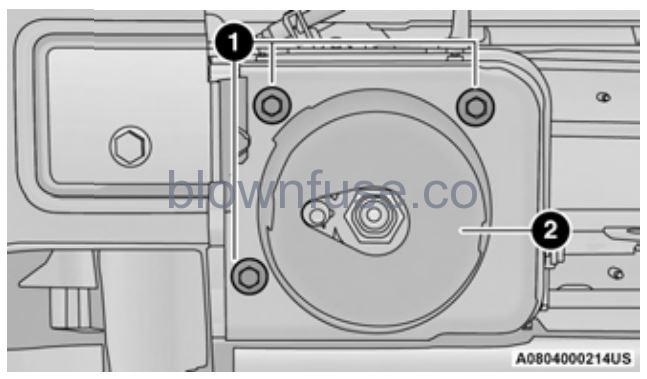
Fuel Filter Assembly- Retainers
- Fuel Filter Protective Cover
- Place drain pan under the fuel filter assembly.
- Open the water drain valve, and let any accumulated water and fuel drain.
- Close the water drain valve.
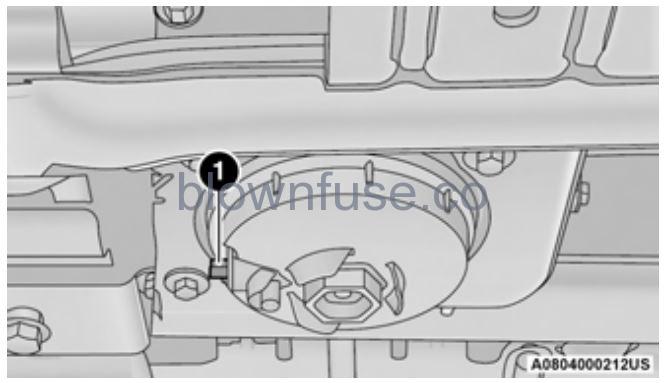
- Water Drain Valve
- Wipe clean the underside of the filter housing to prevent contamination from entering fuel system during service.
- Remove the fuel filter cap and filter from the housing using a socket. Rotate counterclockwise for removal.
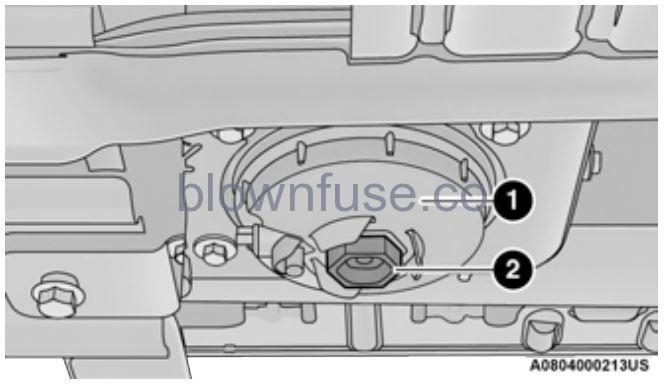
- Fuel Filter Cap
- Socket Adapter
- Remove the used fuel filter cartridge from the cap and dispose of according to your local regulations.
- Wipe clean the sealing surfaces of the cap and housing.
CAUTION! Take care when handling the new fuel filter to prevent contamination from entering the fuel system. - Lubricate o-ring on the cap with clean engine oil.
- Install the new fuel filter cartridge onto the cap.
- Insert the cap and filter into the housing with clockwise rotation, use a socket to tighten.
- Push the ignition switch twice without your foot on the brake to place vehicle in RUN position.
This will activate the in tank fuel pump for approximately 30 seconds. Repeat this process twice to prime the fuel system. Start the engine using the Normal Starting procedure. After engine start, verify the fuel filter cap does not leak.
PRIMING IF THE ENGINE HAS RUN OUT OF FUEL — DIESEL ENGINE
WARNING!
Do not open the high-pressure fuel system with the engine running. Engine operation causes high fuel pressure. High-pressure fuel spray can cause serious injury or death.
- Add a substantial amount of fuel to the tank, approximately 2 to 5 gal (8L to 19L).
- Push ignition switch twice without your foot on brake to put vehicle in RUN position. This will activate the in tank fuel pump for approximately 30 seconds. Repeat this process twice to prime the fuel system.
- Start the engine using the Normal Starting procedure Ú page 143.
CAUTION! The starter motor will engage for approximately 30 seconds at a time. Allow two minutes between cranking intervals.
NOTE:
The engine may run rough until the air is forced from all the fuel lines.
WARNING!
Do not use alcohol or gasoline as a fuel blending agent. They can be unstable under certain conditions and be hazardous or explosive when mixed with diesel fuel.
CAUTION!
Due to lack of lubricants in alcohol or gasoline, the use of these fuels can cause damage to the fuel system.
NOTE:
- Use of biodiesel mixture in excess of 20% can negatively impact the fuel filter’s ability to separate water from the fuel, resulting in high pressure fuel system corrosion or damage.
- In addition, commercially available fuel additives are not necessary for the proper operation of your diesel engine.
- For extreme cold conditions, “Mopar® Premium Diesel Fuel Treatment” is recommended to assist with cold starting.
INTERVENTION REGENERATION STRATEGY — MESSAGE PROCESS FLOW
This engine meets all required diesel engine emissions standards. To achieve these emissions standards, your vehicle is equipped with a state-of-the-art engine and exhaust system. These systems are seamlessly integrated into your vehicle and managed by the Powertrain Control Module (PCM). The PCM manages engine combustion to allow the exhaust system’s catalyst to trap and burn Particulate Matter (PM) pollutants, with no input or interaction on your part. Additionally, your vehicle has the ability to alert you to additional maintenance required on your vehicle or engine.
Refer to Instrument Cluster Display for further information Ú page 120.
WARNING!
A hot exhaust system can start a fire if you park over materials that can burn. Such materials might be grass or leaves coming into contact with your exhaust system. Do not park or operate your vehicle in areas where your exhaust system can contact anything that can burn.
DIESEL EXHAUST FLUID
Diesel Exhaust Fluid (DEF) sometimes known simply by the name of its active component, UREA—is a key component of Selective Catalytic Reduction (SCR) systems, which help diesel vehicles meet stringent emission regulations. DEF is a liquid reducing agent that reacts with engine exhaust in the presence of a catalyst to convert smog-forming Nitrogen Oxides (NOx) into harmless nitrogen and water vapor.
For further information Ú page 424.
ACCESSORY DRIVE BELT INSPECTION
WARNING!
- Do not attempt to inspect an accessory drive belt with the vehicle running.
- When working near the radiator cooling fan, disconnect the fan motor lead. The fan is temperature-controlled and can start at any time regardless of ignition mode. You could be injured by the moving fan blades.
- You can be badly injured working on or around a motor vehicle. Only do service work for which you have the knowledge and the proper equipment. If you have any doubt about your ability to perform a service job, take your vehicle to a competent mechanic.
When inspecting accessory drive belts, small cracks that run across the ribbed surface of the belt, from rib to rib, are considered normal. These are not a reason to replace a belt. However, cracks running along a rib (not across) are not normal. Any belt with cracks running along a rib must be replaced. Also have the belt replaced if it has excessive wear, frayed cords, or severe glazing.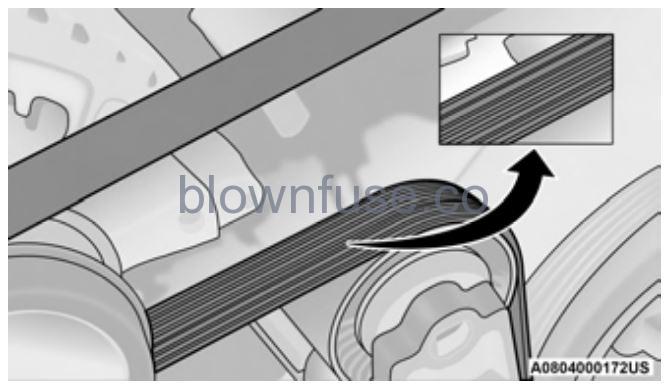
Accessory Belt (Serpentine Belt)
Conditions that would require replacement:
- Rib chunking (one or more ribs has separated from belt body)
- Rib or belt wear
- Longitudinal belt cracking (cracks between two ribs)
- Belt slips
- “Groove jumping” (belt does not maintain correct position on pulley)
- Belt broken
- Noise (objectionable squeal, squeak, or rumble is heard or felt while drive belt is in operation)
NOTE: Identify and correct problem before new belt is installed.
Some conditions can be caused by a faulty component such as a belt pulley. Belt pulleys should be carefully inspected for damage and proper alignment. Belt replacement on some models requires the use of special tools, we recommend having your vehicle serviced at an authorized dealer.
AIR CONDITIONER MAINTENANCE
For best possible performance, your air conditioner should be checked and serviced by an authorized dealer at the start of each warm season. This service should include cleaning of the condenser fins and a performance test. Drive belt tension should also be checked at this time.
WARNING!
- Use only refrigerants and compressor lubricants approved by the manufacturer for your air conditioning system. Some unapproved refrigerants are flammable and can explode, injuring you. Other unapproved refrigerants or lubricants can cause the system to fail, requiring costly repairs. Refer to Warranty Information Book, located in your owner’s information kit, for further warranty information.
- The air conditioning system contains refrigerant under high pressure. To avoid risk of personal injury or damage to the system, adding refrigerant or any repair requiring lines to be disconnected should be done by an experienced technician
CAUTION!
Do not use chemical flushes in your air conditioning system as the chemicals can damage your air conditioning components. Such damage is not covered by the New Vehicle Limited Warranty.
Refrigerant Recovery And Recycling — R–1234yf
R–1234yf Air Conditioning Refrigerant is a Hydrofluoroolefin (HFO) is endorsed by the Environmental Protection Agency and is an ozone-friendly substance with a low global-warming potential. The manufacturer recommends that air conditioning service be performed by an authorized dealer using recovery and recycling equipment.
NOTE:
Use only the manufacturer-approved A/C system PAG compressor oil, and refrigerants.
Cabin Air Filter
WARNING!
Do not remove the cabin air filter while the vehicle is running, or while the ignition is in the ACC or ON/RUN mode. With the cabin air filter removed and the blower operating, the blower can contact hands and may propel dirt and debris into your eyes, resulting in personal injury.
The cabin air filter is located in the fresh air inlet behind the glove compartment. Perform the following procedure to replace the filter:
- Open the glove compartment and remove all contents.
- Push up on the glove compartment travel stop and lower the door.
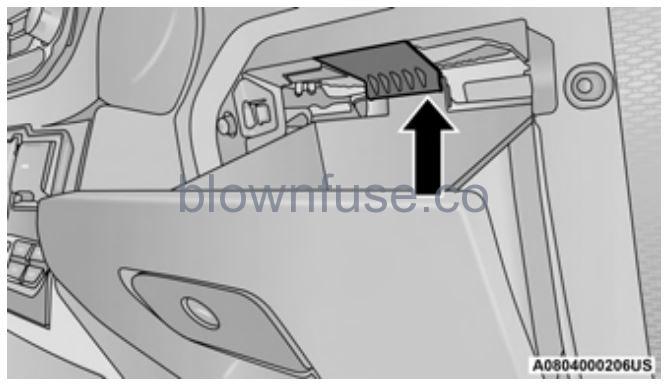
- Pivot the glove compartment downward.
- Disengage the two retaining tabs that secure the air filter access door to the HVAC housing.
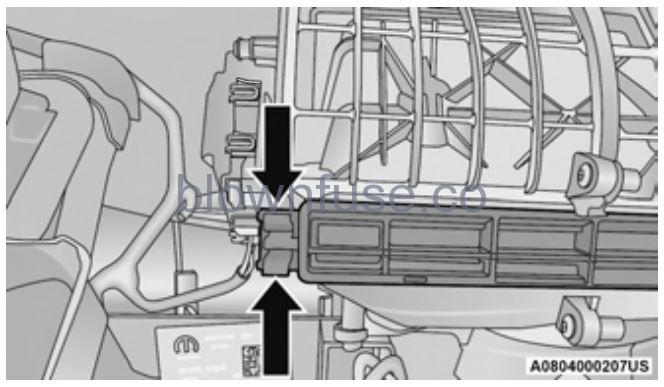
- Remove the air filter from the HVAC air inlet housing. Pull the filter elements out pinching them to the right for clearance.
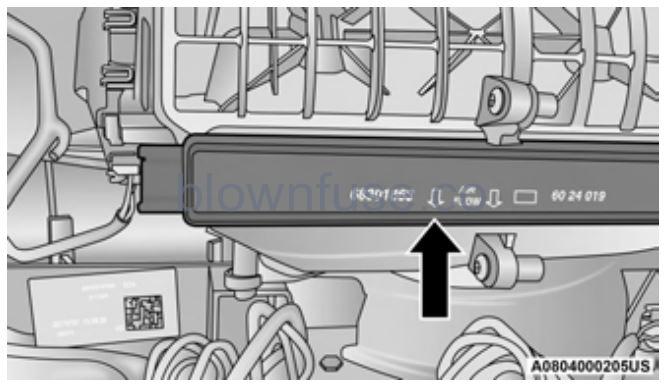
- Install the cabin air filter with the air filter position indicators pointing in the same direction as removal.
CAUTION! The cabin air filter is identified with an arrow to indicate airflow direction through the filter. Failure to properly install the filter will result in the need to replace it more often. - Close cabin air filter access door and secure retaining tabs.
- Rotate the glove compartment door back into position ensuring you have properly engaged the travel damper.
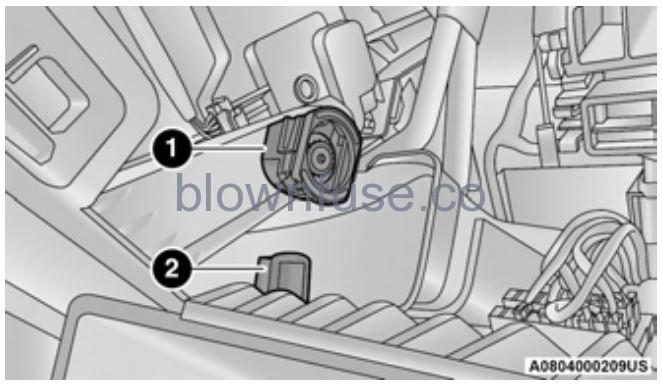
- Travel Dampener Housing
- Travel Dampener Rod
For the proper maintenance intervals, see Ú page 348 for gasoline engines or Ú page 352 for diesel engines.
BODY LUBRICATION
Locks and all body pivot points, including such items as seat tracks, door hinge pivot points and rollers, liftgate, tailgate, decklid, sliding doors and hood hinges, should be lubricated periodically with a lithium based grease, such as Mopar® Spray White Lube to ensure quiet, easy operation and to protect against rust and wear. Prior to the application of any lubricant, the parts concerned should be wiped clean to remove dust and grit; after lubricating excess oil and grease should be removed. Particular attention should also be given to hood latching components to ensure proper function. When performing other underhood services, the hood latch release mechanism, and safety catch should be cleaned and lubricated.
The external lock cylinders should be lubricated twice a year, preferably in the Fall and Spring. Apply a small amount of a high quality lubricant, such as Mopar® Lock Cylinder Lubricant directly into the lock cylinder.
WINDSHIELD WIPER BLADES
Clean the rubber edges of the wiper blades and the windshield periodically with a sponge or soft cloth and a mild nonabrasive cleaner. This will remove accumulations of salt or road film.
Operation of the wipers on dry glass for long periods may cause deterioration of the wiper blades. Always use washer fluid when using the wipers to remove salt or dirt from a dry windshield. Avoid using the wiper blades to remove frost or ice from the windshield. Keep the blade rubber out of contact with petroleum products such as engine oil, gasoline, etc.
NOTE:
Life expectancy of wiper blades varies depending on geographical area and frequency of use. Poor performance of blades may be present with chattering, marks, water lines or wet spots. If any of these conditions are present, clean the wiper blades or replace as necessary. The wiper blades and wiper arms should be inspected periodically, not just when wiper performance problems are experienced. This inspection should include the following points:
- Wear or uneven edges
- Foreign material
- Hardening or cracking
- Deformation or fatigue
If a wiper blade or wiper arm is damaged, replace the affected wiper arm or blade with a new unit. Do not attempt to repair a wiper arm or blade that is damaged.
Wiper Blade Removal/Installation
CAUTION!
Do not allow the wiper arm to spring back against the glass without the wiper blade in place or the glass may be damaged.
- Lift the wiper arm to raise the wiper blade off of the glass, until the wiper arm is in the full up position.
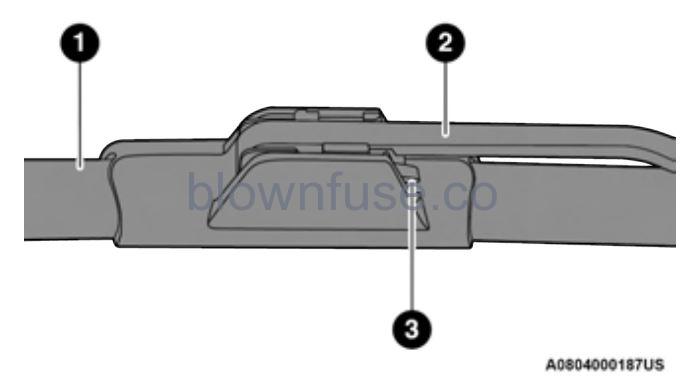
- Wiper Blade
- Wiper Arm
- Release Tab
- To disengage the wiper blade from the wiper arm, push the release tab on the wiper blade and while holding the wiper arm with one hand, slide the wiper blade down towards the base of the wiper arm.
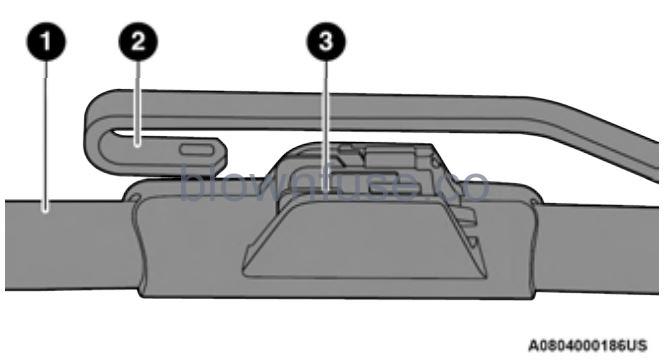
Wiper Blade With Release Tab In Unlocked Position- Wiper Blade
- Wiper Arm J Hook
- J Hook Retainer
- With the wiper blade disengaged, remove the wiper blade from the wiper arm.
- Gently lower the wiper arm onto the glass.
Installing The Front Wipers
- Lift the wiper arm off of the glass, until the wiper arm is in the full up position.
- Position the wiper blade near the hook on the tip of the wiper arm.
- Slide the wiper blade up into the hook on the wiper arm, latch engagement will be accompanied by an audible click.
- Gently lower the wiper blade onto the glass.
Rear Wiper Blade Removal/Installation
- Open swing gate to access the wiper arm.
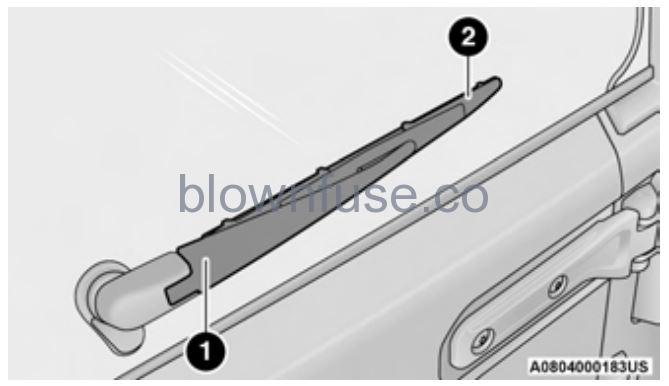
- Wiper Arm
- Wiper Blade
- Lift wiper arm off of the glass and rotate wiper blade outward to disengage the wiper blade from the wiper arm.
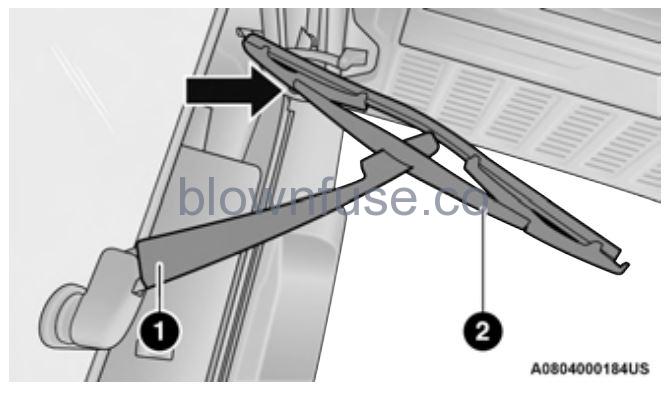
Wiper Blade And Wiper Arm- Wiper Arm
- Wiper Blade
- Gently set the arm on the glass.
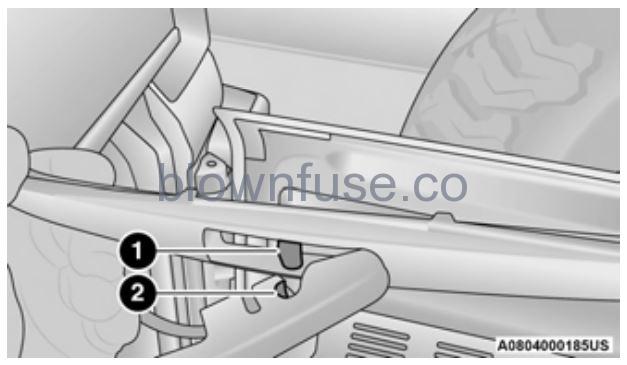
Wiper Blade Removed From Wiper Arm- Wiper Blade Pivot Pin
- Wiper Arm Receptacle
Installing The Rear Wiper
- Lift the wiper arm off of the glass.
- Insert the wiper blade pivot pin into the opening on the end of the wiper arm and rotate the wiper in to place.
- Place with wiper on the glass and close the tail gate.
EXHAUST SYSTEM
The best protection against carbon monoxide entry into the vehicle body is a properly maintained engine exhaust system.
If you notice a change in the sound of the exhaust system; or if the exhaust fumes can be detected inside the vehicle; or when the underside or rear of the vehicle is damaged; have an authorized technician inspect the complete exhaust system and adjacent body areas for broken, damaged, deteriorated, or mispositioned parts. Open seams or loose connections could permit exhaust fumes to seep into the passenger compartment. In addition, have the exhaust system inspected each time the vehicle is raised for lubrication or oil change. Replace as required.
WARNING!
- Exhaust gases can injure or kill. They contain Carbon Monoxide (CO), which is colorless and odorless. Breathing it can make you unconscious and can eventually poison you Ú page 327.
- A hot exhaust system can start a fire if you park over materials that can burn. Such materials might be grass or leaves coming into contact with your exhaust system. Do not park or operate your vehicle in areas where your exhaust system can contact anything that can burn.
CAUTION!
- The catalytic converter requires the use of unleaded fuel only. Leaded gasoline will destroy the effectiveness of the catalyst as an emissions control device and may seriously reduce engine performance and cause serious damage to the engine.
- Damage to the catalytic converter can result if your vehicle is not kept in proper operating condition. In the event of engine malfunction, particularly involving engine misfire or otherapparent loss of performance, have your vehicle serviced promptly. Continued operation of your vehicle with a severe malfunction could cause the converter to overheat, resulting in possible damage to the converter and vehicle.
Under normal operating conditions, the catalytic converter will not require maintenance. However, it is important to keep the engine properly tuned to ensure proper catalyst operation and prevent possible catalyst damage.
NOTE:
Intentional tampering with emissions control systems can result in civil penalties being assessed against you.
In unusual situations involving grossly malfunctioning engine operation, a scorching odor may suggest severe and abnormal catalyst overheating. If this occurs, stop the vehicle, turn off the engine and allow it to cool. Service, including a tune-up to manufacturer’s specifications, should be obtained immediately.
To minimize the possibility of catalytic converter damage:
- Do not interrupt the ignition when the transmission is in gear and the vehicle is in motion.
- Do not try to start the vehicle by pushing or towing the vehicle.
- Do not idle the engine with any ignition components disconnected or removed, such as when diagnostic testing, or for prolonged periods during very rough idle or malfunctioning operating conditions.
COOLING SYSTEM
WARNING!
- You or others can be badly burned by hot engine coolant (antifreeze) or steam from your radiator. If you see or hear steam coming from under the hood, do not open the hood until the radiator has had time to cool. Never open a cooling system pressure cap when the radiator or coolant bottle is hot.
- Keep hands, tools, clothing, and jewelry away from the radiator cooling fan when the hood is raised. The fan starts automatically and may start at any time, whether the engine is running or not.
- When working near the radiator cooling fan, disconnect the fan motor lead or turn the ignition to the OFF mode. The fan is temperature-controlled and can start at any time the ignition is in the ON mode.
Coolant Checks
Check the engine, battery (if equipped), intercooler (if equipped), and Motor Generator Unit (MGU) (if equipped) coolant (antifreeze) protection every 12 months (before the onset of freezing weather, where applicable). If the engine, battery (if equipped), intercooler (if equipped), and MGU (if equipped) coolant is dirty or rusty in appearance, the system should be drained, flushed and refilled with fresh OAT coolant (conforming to MS.90032) by an authorized dealer. Check the front of the A/C condenser (if equipped) or radiator for any accumulation of bugs, leaves, etc. If dirty, clean by gently spraying water from a garden hose vertically down the face of the A/C condenser (if equipped) or the back of the radiator core.
Check the engine, battery (if equipped), intercooler (if equipped), and MGU (if equipped) cooling system hoses for brittle rubber, cracking, tears, cuts, and tightness of the connection at the coolant recovery bottle and radiator. Inspect the entire system for leaks. DO NOT REMOVE THE COOLANT PRESSURE CAP WHEN THE COOLING SYSTEM IS HOT.
Cooling System — Drain, Flush And Refill
NOTE:
Some vehicles require special tools to add coolant properly. Failure to fill these systems properly could lead to severe internal engine damage. If any coolant is needed to be added to the system please contact an authorized dealer. If the engine coolant (antifreeze) is dirty or contains visible sediment, have an authorized dealer clean and flush with OAT coolant (conforming to MS.90032). For the proper maintenance intervals, see Ú page 348 for gasoline engines or Ú page 352 for diesel engines.
Selection Of Coolant
For further information Ú page 424.
NOTE:
- Mixing of engine coolant (antifreeze) other than specified Organic Additive Technology (OAT) engine coolant may result in engine damage and may decrease corrosion protection. OAT engine coolant is different and should not be mixed with Hybrid Organic Additive Technology (HOAT) engine coolant or any “globally compatible” coolant. If a non-OAT engine coolant is introduced into the cooling system in an emergency, the cooling system will need to be drained, flushed, and refilled with fresh OAT coolant (conforming to MS.90032), by an authorized dealer as soon as possible.
- Do not use water alone or alcohol-based engine coolant (antifreeze) products. Do not use additional rust inhibitors or anti-rust products, as they may not be compatible with the radiator engine coolant and may plug the radiator.
- This vehicle has not been designed for use with a propylene glycol-based engine coolant. Use of propylene glycol-based engine coolant is not recommended.
- Some vehicles require special tools to add coolant properly. Failure to fill these systems properly could lead to severe internal engine damage. If any coolant is needed to be added to the system please contact an authorized dealer.
Adding Coolant
Your vehicle has been built with an improved engine coolant (OAT coolant conforming to MS.90032) that allows extended maintenance intervals. This engine coolant (antifreeze) can be used up to 10 years or 150,000 miles (240,000 km) before replacement. To prevent reducing this extended maintenance period, it is important that you use the same engine coolant (OAT coolant conforming to MS.90032) throughout the life of your vehicle. Please review these recommendations for using Organic Additive Technology (OAT) engine coolant that meets the requirements of the manufacturer Material Standard MS.90032. When adding engine coolant (antifreeze):
- We recommend using Mopar® Antifreeze/Coolant 10 Year/150,000 Mile (240,000 km) Formula OAT (Organic Additive Technology) that meets the requirements of the manufacturer Material Standard MS.90032.
- Mix a minimum solution of 50% OAT engine coolant that meets the requirements of the manufacturer Material Standard MS.90032 and distilled water. Use higher concentrations (not to exceed 70%) if temperatures below −34°F (−37°C) are anticipated. Please contact an authorized dealer for assistance.
- Use only high purity water such as distilled or deionized water when mixing the water/engine coolant solution. The use of lower quality water will reduce the amount of corrosion protection in the engine cooling system.
NOTE:
- It is the owner’s responsibility to maintain the proper level of protection against freezing according to the temperatures occurring in the area where the vehicle is operated.
- Use care when filling under hood fluids such as engine oil, washer fluid, antifreeze, etc., to minimize spillage onto the top of the engine. Any excess fluid that is spilled onto the top of the engine should be removed using compressed air or an absorbent cloth.
- Some vehicles require special tools to add coolant properly. Failure to fill these systems properly could lead to severe internal engine damage. If any coolant is needed to be added to the system, please contact an authorized dealer.
- Mixing engine coolant types is not recommended and can result in cooling system damage. If HOAT and OAT coolant are mixed in an emergency, have an authorized dealer drain, flush, and refill with OAT coolant (conforming to MS.90032) as soon as possible.
Cooling System Pressure Cap
The cap must be fully tightened to prevent loss of engine coolant (antifreeze), and to ensure that engine coolant will return to the radiator from the coolant expansion bottle/recovery tank if so equipped. The cap should be inspected and cleaned if there is any accumulation of foreign material on the sealing surfaces.
WARNING!
- Do not open hot engine cooling system. Never add engine coolant (antifreeze) when the engine is overheated. Do not loosen or remove the cap to cool an overheated engine. Heat causes pressure to build up in the cooling system. To prevent scalding or injury, do not remove the pressure cap while the system is hot or under pressure.
- Do not use a pressure cap other than the one specified for your vehicle. Personal injury or engine damage may result.
Disposal Of Used Coolant
Used ethylene glycol-based coolant (antifreeze) OAT or HOAT, is a regulated substance requiring proper disposal. Check with your local authorities to determine the disposal rules for your community. To prevent ingestion by animals or children, do not store ethylene glycol-based coolant in open containers or allow it to remain in puddles on the ground, clean up any ground spills immediately. If ingested, seek emergency assistance immediately.
Coolant Level
The coolant bottle provides a quick visual method for determining that the coolant level is adequate. With the engine OFF and cold, the level of the engine coolant (antifreeze) in the bottle should be between the ranges indicated on the bottle. The radiator normally remains completely full, so there is no need to remove the radiator/coolant pressure cap unless checking for engine coolant freeze point or replacing coolant. Advise your service attendant of this. As long as the engine operating temperature is satisfactory, the coolant bottle need only be checked once a month. When additional engine coolant is needed to maintain the proper level, only OAT coolant that meets the requirements of the manufacturer Material Standard MS.90032 should be added to the coolant bottle. Do not overfill.
Engine Coolant Level — 2.0L
WARNING!
- Do not open hot engine cooling system. Never add engine coolant (antifreeze) when the engine is overheated. Do not loosen or remove the cap to cool an overheated engine. Heat causes pressure to build up in the cooling system. To prevent scalding or injury, do not remove the pressure cap while the system is hot or under pressure.
- Do not use a pressure cap other than the one specified for your vehicle. Personal injury or engine damage may result.
With the engine OFF and cold, the level of the engine coolant should be within the OK range between the ADD and FULL range on the dipstick.
- Remove the cap with a level dipstick from the engine coolant bottle.
- Clean off the coolant from the dipstick.
- Rest the cap on the opening of the coolant bottle without tightening the cap.
- Remove the cap with the dipstick and check the coolant level on the dipstick.
The radiator normally remains completely full, so there is no need to remove the radiator/coolant pressure cap unless checking for engine coolant freeze point or replacing coolant. Advise your service attendant of this. As long as the engine operating temperature is satisfactory, the coolant bottle need only be checked once a month. When additional engine coolant is needed to maintain the proper level, only OAT coolant that meets the requirements of the manufacturer Material Standard MS.90032 should be added to the coolant bottle. Do not overfill.
Cooling System Notes
NOTE:
When the vehicle is stopped after a few miles/kilometers of operation, you may observe vapor coming from the front of the engine compartment. This is normally a result of moisture from rain, snow, or high humidity accumulating on the radiator and being vaporized when the thermostat opens, allowing hot engine coolant (antifreeze) to enter the radiator.
If an examination of your engine compartment shows no evidence of radiator or hose leaks, the vehicle may be safely driven. The vapor will soon dissipate
- Do not overfill the coolant expansion bottle.
- Check the coolant freeze point in the radiator and in the coolant expansion bottle. If engine coolant needs to be added, the contents of the coolant expansion bottle must also be protected against freezing.
- If frequent engine coolant additions are required, the cooling system should be pressure tested for leaks.
- Maintain engine coolant concentration at a minimum of 50% OAT coolant (conforming to MS.90032) and distilled water for proper corrosion protection of your engine which contains aluminum components.
- Make sure that the coolant expansion bottle overflow hoses are not kinked or obstructed.
- Keep the front of the radiator clean. If your vehicle is equipped with air conditioning, keep the front of the condenser clean.
- Do not change the thermostat for Summer or Winter operation. If replacement is ever necessary, install ONLY the correct type thermostat. Other designs may result in unsatisfactory engine cooling performance, poor gas mileage, and increased emissions.
BRAKE SYSTEM
In order to ensure brake system performance, all brake system components should be inspected periodically. For the proper maintenance intervals Ú page 348.
WARNING!
Riding the brakes can lead to brake failure and possibly a collision. Driving with your foot resting or riding on the brake pedal can result in abnormally high brake temperatures, excessive lining wear, and possible brake damage. You would not have your full braking capacity in an emergency.
Fluid Level Check — Brake Master Cylinder
The fluid level of the master cylinder should be checked whenever the vehicle is serviced, or immediately if the Brake System Warning Light is on. If necessary, add fluid to bring level within the designated marks on the side of the reservoir of the brake master cylinder. Be sure to clean the top of the master cylinder area before removing cap. With disc brakes, fluid level can be expected to fall as the brake pads wear. Brake fluid level should be checked when pads are replaced. If the brake fluid is abnormally low, check the system for leaks Ú page 426.
WARNING!
- Use only the manufacturer-recommended brake fluid Ú page 426. Using the wrong type of brake fluid can severely damage your brake system and/or impair its performance. The proper type of brake fluid for your vehicle is also identified on the original factory-installed hydraulic master cylinder reservoir.
- To avoid contamination from foreign matter or moisture, use only new brake fluid or fluid that has been in a tightly closed container. Keep the master cylinder reservoir cap secured at all times. Brake fluid in an open container absorbs moisture from the air resulting in a lower boiling point. This may cause it to boil unexpectedly during hard or prolonged braking, resulting in sudden brake failure. This could result in a collision.
- Overfilling the brake fluid reservoir can result in spilling brake fluid on hot engine parts, causing the brake fluid to catch fire. Brake fluid can also damage painted and vinyl surfaces, care should be taken to avoid its contact with these surfaces.
- Do not allow petroleum-based fluid to contaminate the brake fluid. Brake seal components could be damaged, causing partial or complete brake failure. This could result in a collision.
FRONT/REAR AXLE FLUID
For normal service, periodic fluid level checks are not required. When the vehicle is serviced for other reasons the exterior surfaces of the axle assembly should be inspected. If gear oil leakage is suspected inspect the fluid level.
Fluid Level Check
Lubricant should be approximately 1/8 inch (3 mm) below the bottom edge of the oil fill hole.
NOTE:
Make sure that the vehicle is level and supported by the axles.
Adding Fluid
Add lubricant only at the fill hole and only to the level specified above.
Selection Of Lubricant
Use only manufacturer recommended fluid Ú page 426.
TRANSFER CASE
The fluid level should be to the bottom edge of the fill hole when the vehicle is in a level position.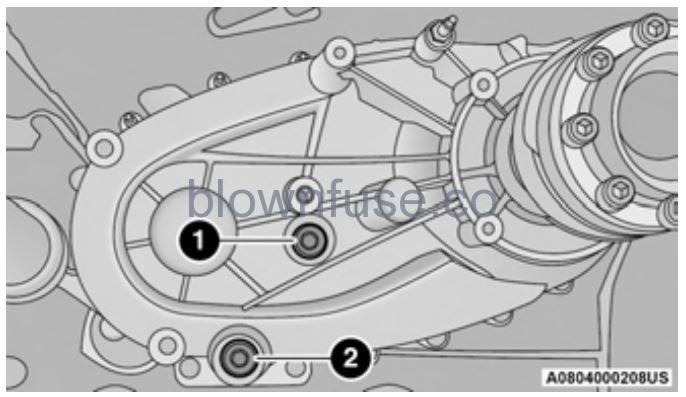
- Fill hole
- Drain hole
Drain And Refill
For the proper maintenance intervals Ú page 348.
Selection Of Lubricant
Use only the manufacturer-recommended fluid Ú page 426.
MANUAL TRANSMISSION — IF EQUIPPED
Fluid Level Check
Check the fluid level by removing the fill plug. The fluid level should be between the bottom of the fill hole and a point not more than 3/16 of an inch (4.76 mm) below the bottom of the hole. Add fluid, if necessary, to maintain the proper level.
Frequency Of Fluid Change
Under normal operating conditions, the fluid installed at the factory will give satisfactory lubrication for the life of the vehicle. If the fluid becomes contaminated with water, it should be changed immediately. Otherwise, change the fluid as recommended in the Maintenance Plan. Refer to the Maintenance Plan for the proper maintenance intervals Ú page 348.
Selection Of Lubricant
Use only the manufacturer-recommended manual transmission fluid Ú page 426.
AUTOMATIC TRANSMISSION — IF EQUIPPED
Special Additives
It is strongly recommended against using any special additives in the transmission. Automatic Transmission Fluid (ATF) is an engineered product and its performance may be impaired by supplemental additives. Therefore, do not add any fluid additives to the transmission. Avoid using transmission sealers as they may adversely affect seals.
CAUTION!
Do not use chemical flushes in your transmission as the chemicals can damage your transmission components. Such damage is not covered by the New Vehicle Limited Warranty.
Fluid Level Check
The fluid level is preset at the factory and does not require adjustment under normal operating conditions. Routine fluid level checks are not required; therefore the transmission has no dipstick. An authorized dealer can check your transmission fluid level using special service tools. If you notice fluid leakage or transmission malfunction, visit an authorized dealer immediately to have the transmission fluid level checked. Operating the vehicle with an improper fluid level can cause severe transmission damage.
CAUTION!
If a transmission fluid leak occurs, visit an authorized dealer immediately. Severe transmission damage may occur. An authorized dealer has the proper tools to adjust the fluid level accurately.
Fluid And Filter Changes
Under normal operating conditions, the fluid installed at the factory will provide satisfactory lubrication for the life of the vehicle. Routine fluid and filter changes are not required. However, change the fluid and filter if the fluid becomes contaminated (with water, etc.), or if the transmission is disassembled for any reason.
Selection Of Lubricant
It is important to use the proper transmission fluid to ensure optimum transmission performance and life. Use only the manufacturer-specified transmission fluid Ú page 426. It is important to maintain the transmission fluid at the correct level using the recommended fluid.
NOTE:
No chemical flushes should be used in any transmission; only the approved lubricant should be used.
CAUTION!
Using a transmission fluid other than the manufacturer recommended fluid may cause deterioration in transmission shift quality and/or torque converter to shudder Ú page 426.
FUSES
General Information
WARNING!
- When replacing a blown fuse, always use an appropriate replacement fuse with the same amp rating as the original fuse. Never replace a fuse with another fuse of higher amp rating.
The use of a fuse with a rating other than indicated may result in a dangerous electrical system overload. If a properly rated fuse continues to blow, it indicates a problem in the circuit that must be corrected. Never replace a blown fuse with metal wires or any other material. Failure to use proper fuses may result in serious personal injury, fire and/or property damage. - Before replacing a fuse, make sure that the ignition is off and that all the other services are switched off and/or disengaged.
- If the replaced fuse blows again, contact an authorized dealer.
- If a general protection fuse for safety systems (air bag system, braking system), power unit systems (engine system, gearbox system) or steering system blows, contact an authorized dealer.
The fuses protect electrical systems against excessive current. When a device does not work, you must check the fuse element inside the blade fuse for a break/ melt. Also, please be aware that using power outlets for extended periods of time with the engine off may result in vehicle battery discharge.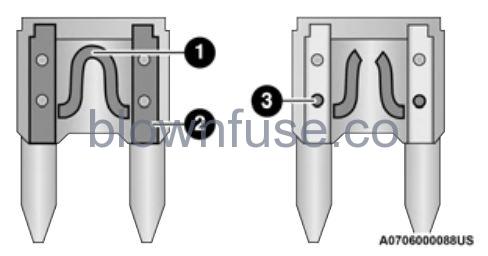
Blade Fuses
- Fuse Element
- Blade Fuse with a good/functional fuse element
- Blade fuse with a bad/not functional fuse element (blown fuse)
Power Distribution Center (PDC)
The Power Distribution Center is located in the engine compartment near the battery. This center contains cartridge fuses, mini fuses, and relays. The PDC top cover is labeled with each serviceable fuse/relay location, function, and size.
CAUTION!
When installing the power distribution center cover, it is important to ensure the cover is properly positioned and fully latched. Failure to do so may allow water to get into the power distribution center and possibly result in an electrical system failure.
Power Distribution Center Location – Gasoline Engine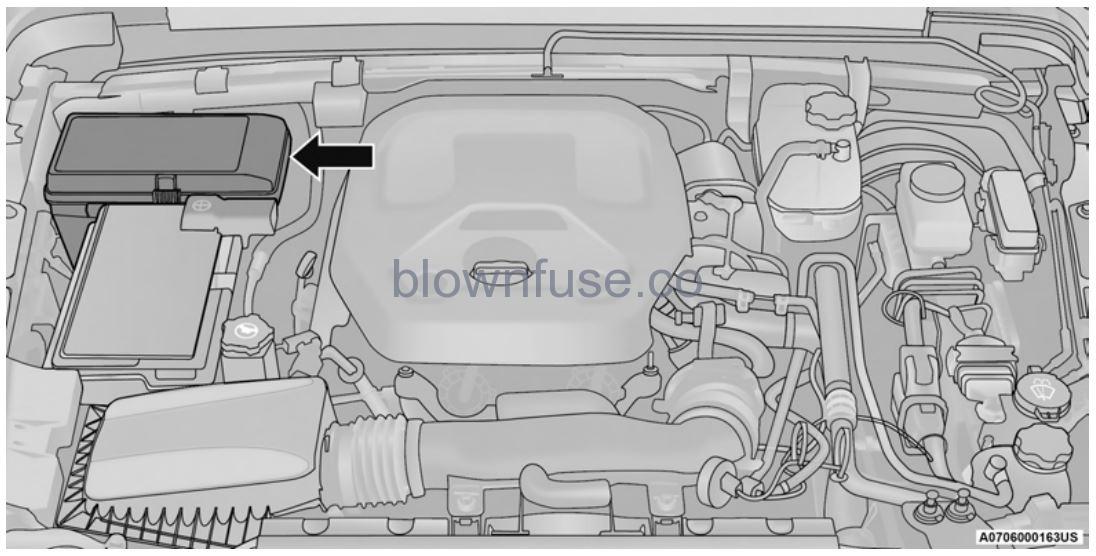
Power Distribution Center Location – Diesel Engine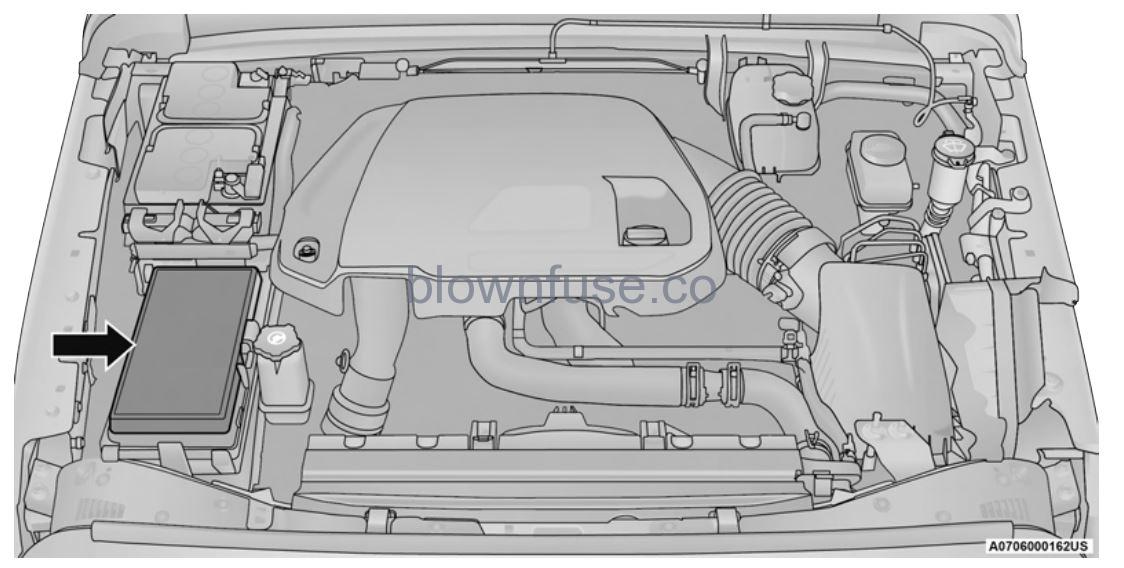
| Cavity | Cartridge Fuse | Micro Fuse | Description |
| * If Equipped | |||
| F01 | – | – | Spare |
| F02 | 40 Amp Green | – | Starter |
| F03 | – | 5 Amp Tan | Intelligent Battery Sensor (IBS) |
| Cavity | Cartridge Fuse | Micro Fuse | Description |
| * If Equipped | |||
| F04 | – | 20 Amp Yellow | Fuel Pump MTR/FPCM |
| 25 Amp Clear | Fuel Pmp (6.4)* | ||
| F05 | – | 5 Amp Tan | Security Gateway |
| F06 | – | – | Spare |
| F07 | – | 15 Amp Blue | Low Temp Radiator Cooling Pump (LTR)* |
| F08 | – | 15 Amp Blue | Trans Control Module TCM-8HP CYGNUS |
| F09 | – | – | Spare |
| F10 | – | 15 Amp Blue | Key Ignition Node (KIN)/Radio Frequency Hub (RF HUB)/ Electric Steering Column Lock (ESCL) |
| F11 | – | 10 Amp Red | UCI Port (USB & AUX) |
| F12 | – | 25 Amp Clear | HIFI Amplifier |
| F13 | – | – | Spare |
| F14 | – | – | Spare |
| F15 | – | 15 Amp Blue | Instrument Panel Cluster (IPC)/Switch Bank-Heavy Duty Electrical Pkg (SWITCH BANK-HD ELEC) |
| F16 | – | – | Spare |
| F17 | – | – | Spare |
| F18 | – | 10 Amp Red | Air Conditioning Clutch (AC CLUTCH) |
| F19 | – | – | Spare |
| F20 | 30 Amp Pink | – | Central Body Controller (CBC) 1-INTERIOR LIGHTS |
| F21 | – | 20 Amp Yellow | REAR WIPER |
| Cavity | Cartridge Fuse | Micro Fuse | Description |
| * If Equipped | |||
|
F22 |
– |
10 Amp Red |
Engine Control Module (ECM)/Powertrain Control Module (PCM)/Motor Generator Unit (MGU) WAKE UP/Power Pack Unit (PPU) WAKE UP |
| F23 | – | 10 Amp Red | Powertrain Control Module (PCM)/Engine Control Module (ECM) |
| F24 | – | – | Spare |
| F25 | – | 10 Amp Red | Module Shift By Wire (MOD_SBW) |
| F26 | 40 Amp Green | – | Central Body Controller (CBC) 2-EXTERIOR LIGHTS #1 |
| F27 | 30 Amp Pink | – | Front Wipers |
| F28 | 40 Amp Green | – | Central Body Controller (CBC) 3-POWER LOCKS |
| F29 | 40 Amp Green | – | Central Body Controller (CBC) 4-EXTERIOR LIGHTS #2 |
| F30 | – | – | Spare |
| F31 | – | 10 Amp Red | DIAGNOSTIC PORT |
|
F32 |
– |
10 Amp Red |
Heating Ventilation Air Conditioning Mod (HVAC CTRL MOD)/ Steering Column Lock (SCL)/Occupant Classification Module (OCM)/Driver Presence Detection Module (DPDM) |
| F33 | – | 10 Amp Red | ParkTronics System (PTS)/Infrared Camera Module (IRCM)/ Airbag Disable Lamps (AIRBAG DISABLE LMPS) |
| F34 | – | 10 Amp Red | Electronic Stability Control (ESC)/Electric Hydraulic Power Steering (EHPS)/Smart Bar Control Module (SBCM) WAKE UP |
| F35 | 30 Amp Pink | – | BRAKE VAC PMP* |
| F36 | 30 Amp Pink | – | TRAILER TOW ELEC BRK MOD* |
| Cavity | Cartridge Fuse | Micro Fuse | Description |
| * If Equipped | |||
| F37 | 30 Amp Pink | – | TRAILER TOW CONN 7W* |
| F38 | 20 Amp Blue | – | Engine Control Module (ECM) |
| F39 | – | 15 Amp Blue | MGU Coolant Pump (3.6)* |
| F40 | – | 15 Amp Blue | DriveTrain Control Module (DTCM)/Axle Lock (AXLE LOC) FT_RR |
| F41 | – | 15 Amp Blue | Instrument Cluster (IC)/Security GateWay (SGW) WAKE UP |
| F42 | – | 10 Amp Red | Power Control Relay Control Feed (Electric Stop/Start)* |
| F43 | – | 20 Amp Yellow | PWR OUTLET (CARGO) BATT |
| F44 | – | 10 Amp Red | InfraRed Camera (IRCAM) HEATERS |
| F45 | – | 20 Amp Yellow | PWR OUTLET (CARGO) IGN |
| F46 | – | 10 Amp Red | AUTO HDLP LVL MOD/LVL MTR/HDLP SW |
| F47 | – | – | Spare |
| F48 | – | – | Spare |
| F49 | – | 10 Amp Red | Occupant Restraint Controller (ORC) |
| F50 | – | 10 Amp Red | HD ACC* |
| F51 | – | 10 Amp Red | Digital TV (DSRC)/USB/InSide RearView Mirror (ISRVM)/ Compass Module (CSGM) |
| F52 | – | 20 Amp Yellow | CIGAR LTR |
| F53 | – | – | Spare |
| F54 | – | – | Spare |
| F55 | – | 10 Amp Red | Central Vision Processing Module (CVPM) |
| Cavity | Cartridge Fuse | Micro Fuse | Description |
| * If Equipped | |||
| F56 | – | 10 Amp Red | IN-CAR TEMP SENSOR/PTC HTR COIL FEED |
| F57 | – | 20 Amp Yellow | Driver Heated Seat |
| F58 | – | 20 Amp Yellow | Pass Heated Seat |
| F59 | – | – | Spare |
| F60 | – | 15 Amp Blue | Comfort Steering Wheel Module (CSWM) (HTD STR WHEEL) |
| F61 | – | 10 Amp Red | Left Blind Spot Sensor (LBSS)/Right Blind Spot Sensor (RBSS) |
| F62 | – | – | Spare |
| 10 Amp Red | Exhaust Sol* | ||
| F63 | – | 10 Amp Red | Occupant Restraint Controller (ORC) |
| F64 | – | – | Spare |
| F65 | – | – | Spare |
| F66 | 40 Amp Green | – | HVAC BLOWER MTR Front |
| F67 | – | – | Spare |
| F68 | – | – | Spare |
| F69 | – | 5 Amp Tan | Motor Generator Unit MGU Belt Starter Generator (BSG)* |
| F70 | – | 25 Amp Clear | INJ/IGN COIL (GAS)/GLO PLUG MOD (DSL) |
| F71 | – | – | Spare |
| F72 | – | 10 Amp Red | HD ELEC ACC PKG* |
| F73 | 20 Amp Blue | – | PWR TOP LT |
| F74 | 20 Amp Blue | – | PWR TOP RT |
| Cavity | Cartridge Fuse | Micro Fuse | Description |
| * If Equipped | |||
|
F75 |
– |
10 Amp Red |
Power Pack Unit – Battery Pack Control Module & Auxiliary Power Module (PPU-BPCM & APM) Belt Starter Generator (BSG)* |
| F76 | – | 20 Amp Yellow | ECM (GAS)/PCM (DSL) |
| F77 | – | 10 Amp Red | HEATED MIRRORS |
| F78 | – | 10 Amp Red | INTRUSION MOD/SIREN/INTRUSION SENSORS |
| F79 | – | 20 Amp Yellow | SMART BAR CTRL MOD |
| F80 | – | 15 Amp Blue | Powertrain Control Module (PCM) / SOL 1,2 BLOCK SHIFT |
| 10 Amp Red | Vapor Blocking Valve (BSG) | ||
| F81 | 30 Amp Pink | – | Rear Defrost (Electric Backlight * |
| F82 | 30 Amp Pink | – | FUEL HTR* |
| F83 | 60 Amp Yellow | – | GLOW PLUG* |
| F84 | 30 Amp Pink | – | UREA HTR CTRL UNIT* |
| F85 | – | 10 Amp Red | PM SENSOR* |
| F86 | 30 Amp Pink | – | BRAKE VAC PMP 2* |
| F87 | – | 10 Amp Red | SUPPLY/PURGING PMP* |
| F88 | 20 Amp Blue | – | NOx SENSOR #1/ #2* |
| F89 | – | 10 Amp Red | Steering Column Control Module (SCCM)/ Cruise Control (CRUISE CTL)/Digital TV (DTV) / EVIC / Airbag Disable Lamp |
| F90 | 20 Amp Blue | – | TRAILER TOW PARK LMP* |
| F91 | – | 20 Amp Yellow | HORN |
| Cavity | Cartridge Fuse | Micro Fuse | Description |
| * If Equipped | |||
| F92 | 40 Amp Green | – | HD ACCY #2* |
| F93 | 40 Amp Green | – | HD ACCY #1* |
| F94 | – | – | Spare |
| F95 | – | – | Spare |
| F96 | – | 10 Amp Red | PWR MIRROR SW |
| F97 | – | 20 Amp Yellow | RADIO/TBM |
| F98 | – | 10 Amp Red | SW BANK-HD ELEC/OFF ROAD |
| F99 | – | – | Spare |
| F100 | 30 Amp Pink | – | ESC-ECU & VALVES |
| F101 | 30 Amp Pink | – | DriveTrain Control Module (DTCM) |
| F102 | – | 15 Amp Blue | DUAL USB PORT |
| F103 | – | 15 Amp Blue | HD ACCY #3* |
| F104 | – | 15 Amp Blue | PPU COOL PUMP* |
| F105 | – | 10 Amp Red | Integrated Center Stack (ICS)/Heat Ventilation Air Conditioning (HVAC) |
| F106 | 50 Amp Red | – | ESC -PUMP MTR |
| F107 | – | 20 Amp Yellow | TRAILER TOW STOP/TURN LT* |
| F108 | – | 15 Amp Blue | HD ACCY #4* |
| F109 | – | 20 Amp Yellow | TRAILER TOW STOP/TURN RT* |
| Cavity | Cartridge Fuse | Micro Fuse | Description |
| * If Equipped | |||
| F110 | 30 Amp Pink | – | POWER INVERTER |
| F111 | 20 Amp Blue | – | TRAILER TOW BACKUP* |
Customers can select to switch the Cargo Power Outlet from F43 battery fed power to this position F45 which is fed when the ignition in ON.
BULB REPLACEMENT
Replacement Bulbs, Names, And Part Numbers
In the instance a bulb needs to be replaced, this section includes bulb description and replacement part numbers.
NOTE: See an authorized dealer for LED bulb replacement
| Interior Bulbs | |
| Bulb Name | Bulb Number |
| Automatic Transmission Indicator Lamp | 658 |
| Heater Control Lamps (2) | 194 |
| Rocker Switch Indicator Lamp (Rear Window Defogger, and Rear Wash/Wipe) | ** |
| Soundbar Dome Lamp | 912 |
Bulbs only available from an authorized dealer
| Exterior Bulbs | |
| Bulb Name | Bulb Number |
| Headlamps (2) | H13 |
| Premium Head Lamps | LED |
| Sport Front Park/Turn Signal Lamps (2) | 7444NALL |
| Premium Front Park/Turn Signal Lamps (2) | LED |
| Base (Sahara/Rubicon) Turn Lamp | 7440NALL/WY21WLL |
| Base (Sahara/Rubicon) Park DRL Lamp | 7443LL |
| Front Side Marker Lamps (2) | LED |
| Base Fog Lamps | PSX24W |
| Premium Fog Lamps | LED |
| Rear Premium LED Tail Lamps | LED |
| Rear Base Tail Lamp Stop/Tail/Turn Bulb | 3157 |
| Rear Base Tail Lamp Backup Bulb | 7440 |
| Rear Base Tail Lamp Side Marker | LED |
| Center High Mounted Stop Lamp (CHMSL) | LED |
| License Lamp | LED |
| NOTE:
Numbers refer to commercial bulb types that can be purchased from an authorized dealer. If a bulb needs to be replaced, visit an authorized dealer or refer to the applicable Service Manual. |
|
Bulb Replacement
NOTE:
Lens fogging can occur under certain atmospheric conditions. This will usually clear as atmospheric conditions change to allow the condensation to change back into a vapor. Turning the lamps on will usually accelerate the clearing process.
HALOGEN HEADLAMPS — IF EQUIPPED
See the following steps to replace:
- Open hood and support using prop rod.
- Remove the front grille. Turn the retainers
along the top a quarter-turn counterclockwise
and remove. - Pull the bottom of the grille away starting at
one side and working toward the other. - Remove the three screws holding the headlamp to the vehicle.
- Remove lamp from the vehicle.
- Remove the lamp from the collar.
- Grab the bulb and rotate a quarter-turn counterclockwise.
- Pull the bulb from the housing.
- Push connector locking tab to the unlock position.
- Remove connector from bulb.
- Push connector onto new bulb base, and push the connector locking tab to the lock position.
CAUTION!
Do not touch the new bulb with your fingers. Oil contamination will severely shorten bulb life. If the bulb comes in contact with any oily surface, clean the bulb with rubbing alcohol. - Reinstall bulb housing. Rotate the bulb a quarter turn clockwise.
FRONT PARK/TURN SIGNAL — IF EQUIPPED
See the following steps to replace:
- Remove the front wheel liner fasteners to access bulb sockets.
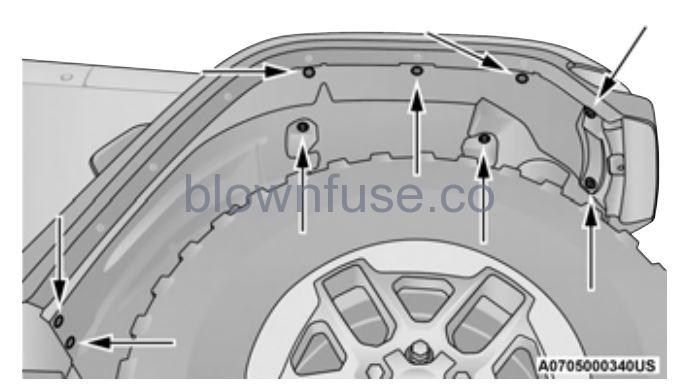
- Turn the socket assembly a quarter-turn counterclockwise and remove from the housing. Pull the bulb straight from the socket to replace it.
LED FRONT SIDE MARKER — IF EQUIPPED
See the following steps to replace:
- Remove the front wheel liner fasteners to access side maker screw and electrical connector.
- Remove fastening screw in the back of the front side maker assembly and disconnect electrical connector.
- Remove and replace LED front side marker light assembly.
HALOGEN FRONT FOG LAMP — IF EQUIPPED
See the following steps to replace:
- Reach under the vehicle to access the back of the front fog lamp.
- Disconnect the wire harness connector from the front fog lamp connector receptacle.
- Firmly grab the bulb by the two latch features and squeeze them together to unlock the bulb from the back of the front fog lamp housing.
- Pull the bulb straight out from the keyed opening in the housing and then connect the replacement bulb.\
CAUTION!
Do not touch the new bulb with your fingers. Oil contamination will severely shorten bulb life. If the bulb comes in contact with any oily surface, clean the bulb with rubbing alcohol.
LED Front Fog Lamp
If your vehicle is equipped with LED fog lamps they are replaced as an assembly.
REAR TAIL, STOP, TURN SIGNAL, AND BACKUP LAMP — IF EQUIPPED
See the following steps to replace:
- Remove interior trim panel cap to access single retaining screw for tail lamp assembly.
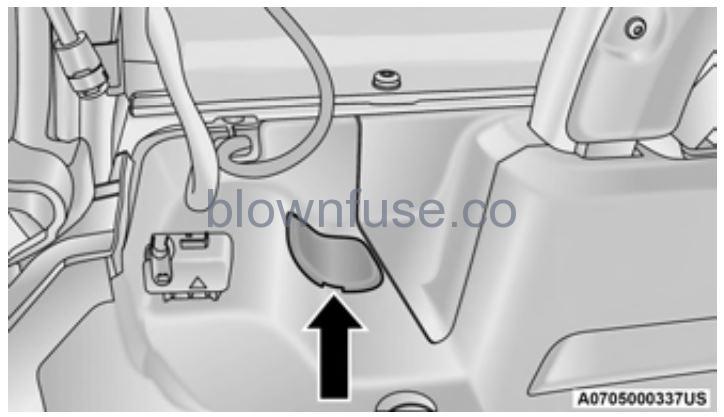
- Remove retaining screw and disconnect electrical connector, then remove tail lamp assembly from the vehicle.
NOTE: If necessary, push in on the assembly tab located inboard behind the lamp housing.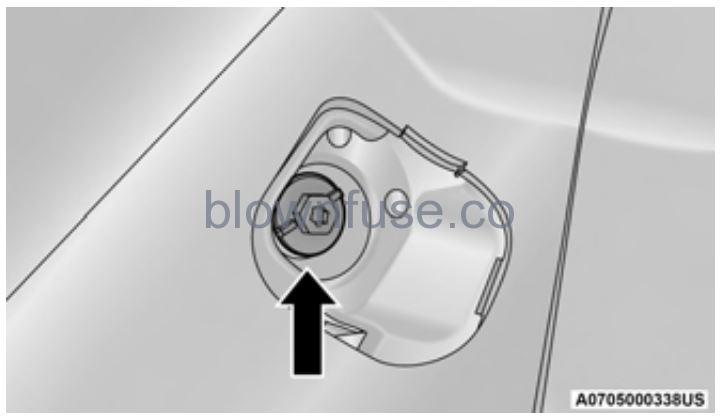
- Remove the three screws from the assembly bracket to access bulb sockets.
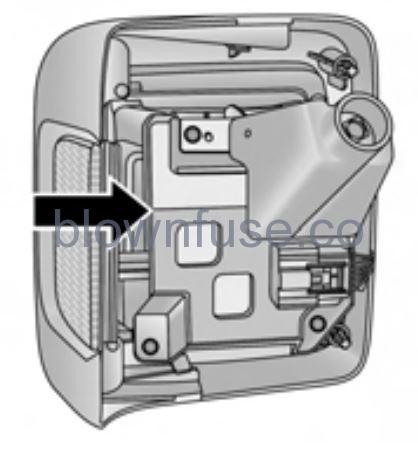
- Rotate the appropriate socket a quarter turn counterclockwise, then remove it from the housing.
- Pull the bulb straight from the socket to replace it.
CENTER HIGH MOUNTED STOP LAMP (CHMSL) — IF EQUIPPED
The stop lamp is mounted on a bracket that extends upward from the swing gate behind the spare tire. If service is needed, obtain the LED Assembly from an authorized dealer.
See the following steps to replace:
- Remove the spare tire.
- Remove the screws holding the tire carrier cover.
- Remove two screws from lamp assembly and disconnect electrical connector.
LICENSE PLATE LAMPS — IF EQUIPPED
See the following steps to replace:
NOTE:
To install a new bulb, reverse the procedure above. When installing the new bulb, care should be taken to not allow bare skin to come in contact with the bulb.
See an authorized dealer to replace LED lamps.
